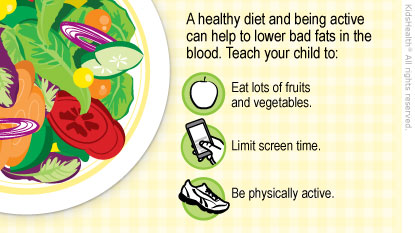Dyslipidemia: How to Care for Your Child
Blood tests show that your child has dyslipidemia (dis-lip-id-EE-mee-ah), a condition in which too many bad fats and not enough good fats are in the blood. A healthy diet and regular physical activity can get the fats in better balance. This helps prevent heart disease later in life.


-
Serve foods that are low in saturated fats, trans fats, and sugar, and avoid refined grains (such as white flour). Choose fiber-rich foods, including whole grains (such as whole wheat flour), fruits, and vegetables.
-
Include omega-3 fatty acids in your child's diet. They are found in foods such as fatty fish (like salmon), walnuts, flax seeds, and olive oil.
-
Help your child maintain a healthy weight:
-
Give your child 5 or more servings of fruits and vegetables every day.
-
Limit your child's non-school screen time (TV, computer, tablet, phone, and video games).
-
Make sure your child gets 1 hour or more of moderate to vigorous exercise every day.
-
If your child is overweight, follow the weight-loss plan the health care provider recommends.
-
Your child shouldn't smoke and should avoid secondhand smoke.
-
Give your child any prescribed medicines as directed by the health care provider.
-
Encourage the whole family to eat well and be active together. This will make it easier for your child to make healthy choices.


What is dyslipidemia? Dyslipidemia is when someone has unhealthy levels of the lipids (fats) cholesterol and/or triglycerides in their bloodstream. The body needs these fats to make cell membranes and some hormones, and to help store energy. But children who have high levels of cholesterol and triglycerides are more likely to have heart disease when they grow up. Correcting the balance of fats now can prevent these problems.
Dyslipidemia can include any combination of these:
-
high total cholesterol
-
high low-density lipoprotein (LDL, or "bad") cholesterol
-
high triglycerides
-
low high-density lipoprotein (HDL, or "good") cholesterol
What causes dyslipidemia? Poor diet and an inactive lifestyle can cause dyslipidemia or make it worse. Smoking raises LDL cholesterol and triglycerides and lowers HDL cholesterol. Dyslipidemia also runs in some families. In some kids, certain medical problems (such as hypothyroidism, diabetes, or kidney or liver disease) can cause dyslipidemia.